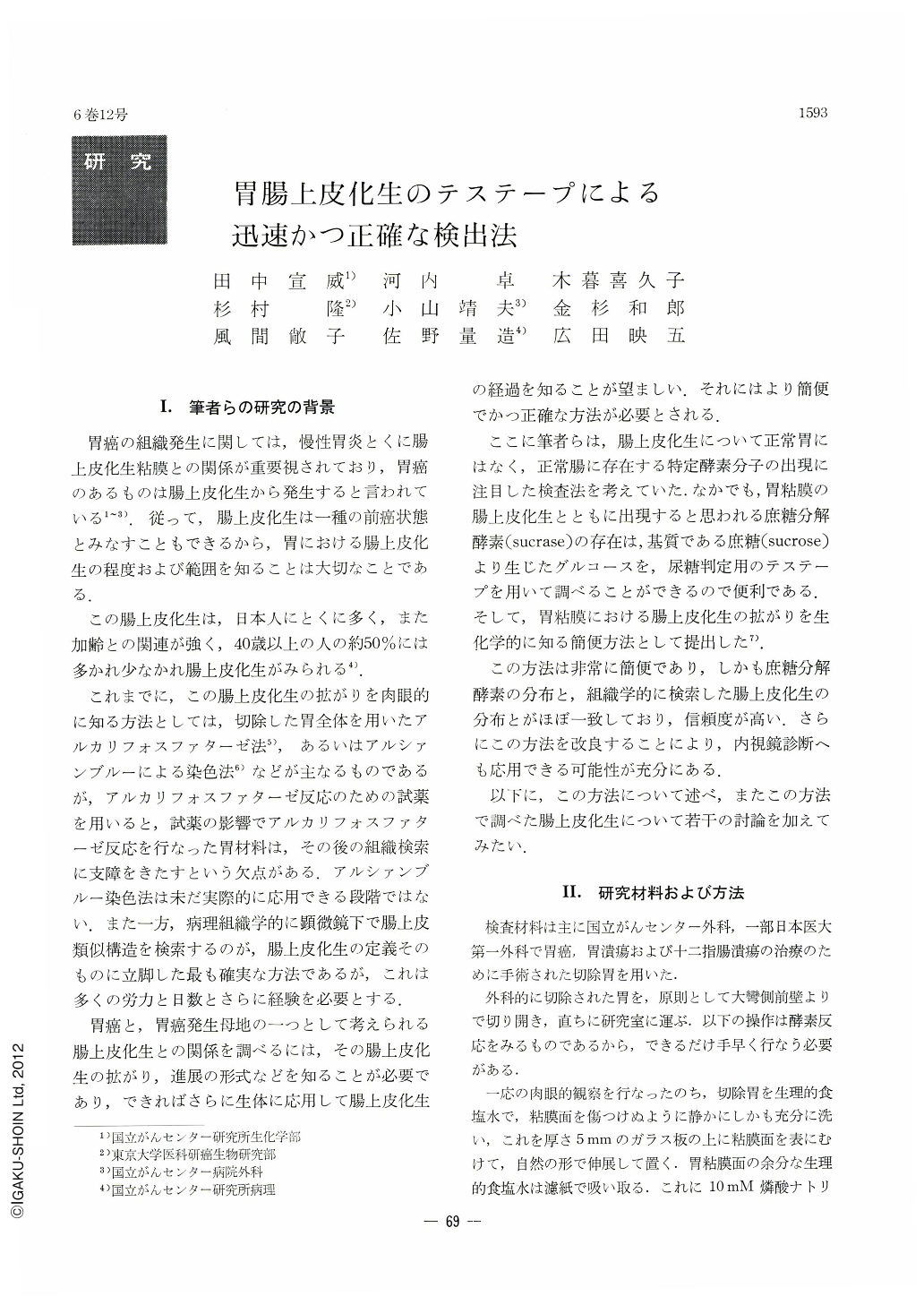Japanese
English
- 有料閲覧
- Abstract 文献概要
- 1ページ目 Look Inside
Ⅰ.筆者らの研究の背景
胃癌の組織発生に関しては,慢性胃炎とくに腸上皮化生粘膜との関係が重要視されており,胃癌のあるものは腸上皮化生から発生すると言われている1)~3).従って,腸上皮化生は一種の前癌状態とみなすこともできるから,胃における腸上皮化生の程度および範囲を知ることは大切なことである.
この腸上皮化生は,日本人にとくに多く,また加齢との関連が強く,40歳以上の人の約50%には多かれ少なかれ腸上皮化生がみられる4).
In studies on the histogenesis of gastric carcinomas, it was noticed that carcinoma was frequently associated with intestinal metaplasia. Accordingly, it seemed important to examine the relationship between gastric carcinoma and intestinal metaplasia. This paper reports appearance of disaccharidases, which are characteristic intestinal emzymes in gastric mucosa showing intestinal metaplasia.
Based on this finding we designed a novel method to detect the range and grade of intestinal metaplasia in gastric mucosa by visualizing the sucrase activity with Tes-Tape. This method is very simple and does not require any complicated reagents or tedious procedures.
Specimens were obtained by gastrectomy from patients with gastric carcinomas, gastric ulcers or duodenal ulcers. The surface of the stomach was washed thoroughly with cold saline and excess fluid was removed with filter paper. The stomach was then spread out on a thick glass plate and sprayed with a solution of 5% sucrose, maltose or lactose in 10 mM sodium phosphate buffer. The specimen was incubated at 37℃ for 5min. Then, the whole surface of the gastric mucosa was quickly covered with Tes-Tapes (Eli-Lilly and Co., Indianapolis, U.S.A.). The Tes-Tapes over areas of intestinal metaplasia turned green, since glucose was produced by the disaccharidase in these areas.
This method is highly sensitive for detection of glucose, so areas of intestinal metaplasia can easily be detected. The areas of Intestinal metaplasia detected by this method were usually in the antral region, though some extended to the corpus. It should be emphasized that area of carcinoma gave a negative reaction for sucrase.
If the Tes-Tapes give a yellow region inside a green area, the existence of the gastric carcinoma should be suspected. Thus this methocl to detect sucrase activity may also be applicable for detection of early gastric carcinoma.
Using Tes-Tape, the changes in the patterns of appearance of sucrase, maltase and lactase in the mucosa of the intestinal tract during postnatal development of rats were examined. Lactase activity was present in the intestine in prenatal rats and its activity disappeared after weaning. Maltase activity was present in the all digestive tract in prenatal rats and its activity increased after weaning. Later its activity was only found in the small intestine. Sucrase activity was not present in new born rats but appeared in the small intestine during weaning.
The presence of these three enzymes in areas of intestinal metaplasia of the gastric mucosa was examined and maltase activity was observed in areas showing sucrase activity. It was found that giving a positive reaction for maltase were more extensive than those showing sucrase activity. The appearance of maltase activity may precede that of sucrase activity as during normal development of the intestinal mucosa in rats. It is interesting that lactase was sometimes found in areas of intestinal metaplasia.
From these results, we may conclude that there is some kind of abnormality in the patterns of gene expressions in intestinal metaplasia.
This method could be used in endoscopic examination after modification for application in vivo and will be useful for examine intestnal metaplasia in situ and detecting early gastric carcinoma.

Copyright © 1971, Igaku-Shoin Ltd. All rights reserved.


